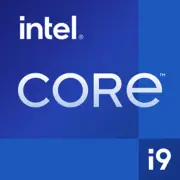Intel Core i9-10885H

Intel Core i9-10885H: The Power of Comet Lake in the Age of New Technologies
April 2025
Despite the emergence of 5nm and 3nm processors, some solutions from previous years remain relevant due to their balance of price and performance. One such example is the Intel Core i9-10885H, released in 2020. Let's explore who in 2025 should pay attention to this CPU and what tasks it can handle.
Architecture and Process: 14nm, 8 Cores, and Turbo Modes
Comet Lake-H: The Final Push of 14nm
The Core i9-10885H belongs to the Comet Lake-H family, which represents the pinnacle of Intel's 14nm technology development. This is an 8-core processor with 16 threads thanks to Hyper-Threading. The base frequency is 2.4 GHz, with a maximum in turbo mode of 5.3 GHz (for a single core).
Architecture Features:
- 16MB L3 Cache — enhances the performance of multi-threaded tasks (rendering, encoding).
- Integrated Intel UHD Graphics for 10th Generation — 24 EU (Execution Units), frequency up to 1.2 GHz. Suitable for basic tasks: office applications, 4K video, casual gaming (e.g., CS:GO on low settings).
- Supports DDR4-2933 Memory — relevant for workstations.
Why 14nm is Not a Sentence?
Although the 14nm process lags behind modern 7nm (AMD) or 5nm (Apple) in energy efficiency, Intel has optimized the architecture for maximum performance at high frequencies. This makes the i9-10885H competitive in tasks where single-core speed is crucial.
Power Consumption and TDP: 45W and Cooling Realities
TDP of 45W: What Does It Mean in Practice?
The nominal TDP of 45W is an average figure. In turbo mode, power can reach 100-120W, requiring an efficient cooling system. In laptops, this means:
- A thick chassis (20-25 mm) with large heatsinks.
- Noisy fans under load.
- The risk of throttling (frequency reduction) in compact devices.
Example: The MSI GE66 Raider laptop with the i9-10885H and RTX 3080 demonstrates stable performance in games, but during prolonged rendering, the CPU temperature reaches 95°C, which is typical for Comet Lake.
Performance: Gaming, Editing, and Office Work
Geekbench 6: 1539 (Single-Core), 6521 (Multi-Core)
These results show that the i9-10885H still outperforms many budget modern CPUs in single-threaded tasks.
Real-World Scenarios:
1. Office and Multimedia:
- Running 50+ tabs in Chrome + streaming 4K video — no lag.
- Photoshop, Lightroom: processing RAW files at 30MP takes 1-2 seconds per operation.
2. Gaming:
- In combination with a discrete GPU (e.g., RTX 4070): Cyberpunk 2077 on Ultra (1080p) — 75-90 FPS.
- Turbo mode supports high frequencies during short loads (level loading, shooter skirmishes).
3. Professional Tasks:
- Premiere Pro: rendering a 10-minute 4K H.264 video — about 8-10 minutes.
- Blender (BMW scene): 4 minutes 20 seconds — worse than the Ryzen 9 5900HX (3 minutes 50 seconds), but better than the i7-10750H.
Turbo Boost Max 3.0 Mode:
This technology automatically boosts the most powerful cores. For example, in games, 2-4 cores can operate at 5.1-5.3 GHz, ensuring smooth FPS.
Use Cases: Who Should Choose the i9-10885H in 2025?
1. Budget Gamers. Laptops with this processor now cost $1200-$1700 (new models are rare, but stock remains). A good choice for gaming with an RTX 4070 or similar GPU.
2. Engineers and Designers. Support for Thunderbolt 3 and 64GB DDR4 is relevant for CAD software.
3. Users Who Value Compatibility. Windows 11 and older enterprise applications run more reliably than on ARM processors.
Who Should Avoid It:
- Those who value battery life (less than 4 hours with active use).
- Fans of thin ultrabooks (chassis thickness from 20 mm).
Battery Life: A Compromise Between Power and Runtime
80-90 Wh Battery: Realities of 2025
Even with modern energy-efficient displays and SSDs, laptops with the i9-10885H rarely last more than 5-6 hours in web browsing mode. The reason is the high power consumption of the CPU.
Power-Saving Technologies:
- Intel Speed Shift — fast frequency adjustment to reduce power consumption.
- Adaptix Thermal Framework — dynamic cooling management.
- Windows "Battery Saver" mode — caps frequencies at 1.5 GHz.
Tip: To extend battery life, disable Turbo Boost in power settings.
Comparison with Competitors: AMD, Apple, and Previous Generations
1. AMD Ryzen 9 5900HX (Zen 3, 7nm):
- Better in multi-threaded tasks (+15% in Cinebench R23).
- Worse in single-threaded (-8% compared to the i9-10885H).
- TDP of 45W, but more efficient due to 7nm process.
2. Apple M2 Pro (5nm):
- Twice the battery life.
- Incompatibility with Windows and many games.
3. Intel Core i7-13700H (Raptor Lake, 10nm):
- +20% in multi-threaded performance.
- Laptop prices starting from $1800.
Conclusion: The i9-10885H is a choice for those who prioritize price and single-threaded performance.
Pros and Cons
Strengths:
- High turbo frequencies for gaming and demanding applications.
- Support for Thunderbolt 3 and Wi-Fi 6.
- Affordable price in the used and new leftover device segment ($1000-$1500).
Weaknesses:
- Heat and noise from the cooling system.
- No support for PCIe 4.0.
- Inferior performance to Ryzen in multi-threading.
Recommendations for Laptop Selection
1. Type of Device:
- Gaming Laptop (ASUS ROG Strix, MSI GP66) — focus on cooling.
- Mobile Workstation (Dell Precision 7550) — support for ECC memory.
2. What to Look For:
- Number of heat pipes (at least 3).
- Battery capacity of at least 80Wh.
- Thunderbolt 3 ports for external GPUs or storage.
Final Conclusion
The Intel Core i9-10885H in 2025 is a choice for:
- Gamers who want to save money but are not ready to upgrade to the 13th generation of Intel.
- Professionals working with applications sensitive to frequency (e.g., AutoCAD).
- Users who require maximum compatibility with Thunderbolt 3 peripherals.
Key Benefits: Power in single-threaded tasks, affordable price, and proven reliability. However, these advantages come at the cost of battery life and compactness.
Basic
CPU Specifications
Memory Specifications
GPU Specifications
Miscellaneous
Benchmarks
Compared to Other CPU
Share in social media
Or Link To Us
<a href="https://cputronic.com/cpu/intel-core-i9-10885h" target="_blank">Intel Core i9-10885H</a>